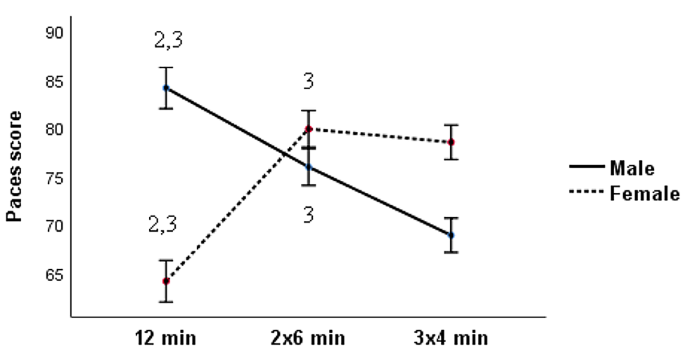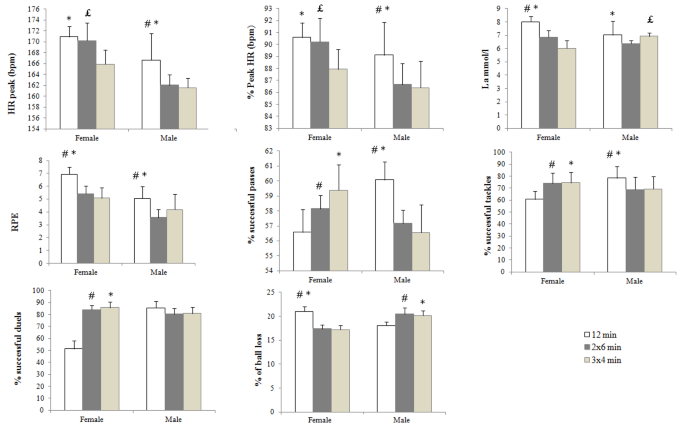Perceived enjoyment
Regarding the perceived enjoyment, Mixed ANOVA testing showed a significant interaction effect between both factors: bout duration x gender (F2,30 = 294.42, p < 0.001, ηp 2 = 0.9). Indeed, among female soccer players, PE scores are inversely proportional to the length of the bout duration of SSGs. Bonferroni post hoc analyses showed that there was a lower PE for continuous bout duration 1 × 12 min compared to the medium intermittent bout duration 2 × 6 min [mean difference (md) = 15.75, p < 0.001, dunb = 6.74, 95%CI = 13.43 to 18.06] and the short intermittent bout duration 3 × 4 min [md = 14.37, p < 0.01, dumb = 4.93, 95%CI = 11.57 to 17.14]. Similarly, the PE scores are significantly lower in the medium intermittent bout duration (2 × 6 min) than that of the short intermittent bout duration (3 × 4 min): [md = 1.37, p < 0.05, dumb = 0.57, 95%CI = 0.51 to 2.49].
On the other hand, among male soccer players, continuous bout duration (1 × 12) was characterized by a significantly higher PE (Fig. 1) compared to medium intermittent bout duration 2 × 6 min (md = 8.18 p < 0.001, 95%CI [6.18–10.18], dumb = 1.62 and the short intermittent bout duration 3 × 4 min (md = 15.25, p < 0.001, 95%CI [12.14–18.35], dumb = 3.33. The same, our results showed also significantly higher PE scores during the medium intermittent bout duration (2 × 6 min) compared to the short intermittent bout duration 3 × 4 min (m.d = 7.06, p < 0.001, 95%CI [4.15–9.96], dumb = 1.59). The full set of post-hoc pairwise comparisons and interaction effects are presented in Fig. 1.
Comparison between means paces score of male and female soccer players after different bout durations of small-sided games (12 min, 2 × 6 min, and 3 × 4 min). 1,2,3: statistically significant difference within Condition 1: 1 × 12 min; 2: 2 × 6 min; 3: 3 × 4 min respectively. PACES: Physical Activity Enjoyment Scale
Physiological responses
Statistical analysis showed a significant interaction effect between bout duration and gender on the peak HR of the game: F (2.30) = 5.27, p < 0.01, ηp2 = 0.15, % HR peak: F(2.30) = 5.38, p < 0.01, ηp2 = 0.15, La: F(2,30) = 21.69, p < 0.001, ηp2 = 0.4 and RPE: F(2,30) = 4.9, p < 0.05, ηp2 = 0.14 (Table 1). Bonferroni post hoc analyses showed significant differences within bout duration in female as well as in male soccer players. In effect, during continuous bout duration 1 × 12 min and medium intermittent bout duration 2 × 6 min, PeakHR and %HRpeak was significantly increased in female soccer players compared to the short intermittent bout duration 3 × 4 min [PeakHR: 1 × 2 min: md = 5, p < 0.001,dunb = 2.18, 95%CI = 3.29 to 6.7, PeakHR: 2 × 6 min: md = 4.31, p < 0.01, dunb = 0.73, 95%CI = 1.39 to 7.23], [%HRpeak: 1 × 12 min: md = 2.64, p < 0.001, dunb = 1.85, 95%CI = 1.74 to 3.55, %HRpeak: 2 × 6 min: md = 2.28, p < 0.01, dunb = 1.26, 95%CI = 0.74 to 3.82]. The values of La concentration and RPE were significantly greater only in continuous bout duration 1 × 12 min compared to the medium intermittent bout duration 2 × 6 min [La: md = 1.14, p < 0.001, dunb = 2.59, 95%CI = 0.72 to 1.55; RPE: md = 1.18, p < 0.01, 95%CI = 0.44 to 1.93, dunb = 1.66] and 3 × 4 min [La: md = 1.98, p < 0.001, dunb =, 95%CI = 1.47 to 2.48; RPE: md = 1.62, p < 0.001, 95%CI = 0.93 to 31, dunb = 2.02).
On the other hand, in male soccer players, Continuous bout duration “1 × 12 min” was characterized by a significantly greater peakHR, %HRpeak, La, and RPE compared to medium intermittent bout duration “2 × 6 min” [peak HR: md = 4.62, p < 0.01, dunb = 1.35, 95%CI = 1.65 to 7.59; %HR: md = 2.46, p < 0.01, dunb = 1.2, 95%CI = 0.89 to 4.03; La: md = 0.63 dunb = 1.04, p < 0.01, 95%CI = -0.14 to 1.41; RPE: md = 1.5, p < 0.01, dunb = 1.94, 95%CI = 0.64 to 2.35] and the short intermittent bout duration 3 × 4 min [peak HR: md = 5.12, p < 0,01 dunb = 1.52, 95%CI = 1.53 to 8.71; %HR: md = 2.72, p < 0.01, dunb = 1.1, 95%CI = 0.83 to 4.16; RPE: md = 0.87, p < 0.05, dunb = 0.81, 95%CI = 0.02 to 1.72]. The full set of post-hoc pairwise comparisons are presented in Fig. 2.
Technical and tactical performances
A significant interaction existed between the bout duration and the gender for % successful passes (F2.30 = 43.43, p < 0.001, ηp2 = 0.59), % successful tackles (F2,30 = 18.39, p < 0.001, ηp2 = 0.38), % successful duels (F2,30 = 148.38, p < 0.001, ηp2 = 0.83) and, % ball loss (F2,30 = 118.59, p < 0.001, ηp2 = 0.79) Table 1. This result may imply that the effects of bout duration on these variables depend on the gender of participants. Post hoc analyses showed that in female soccer players, the percentage of successful passes, successful tackles, successful duels, and ball loss were higher during the short intermittent bout duration (3 × 4 min) compared to 1 × 12 min [% successful passes: md = 2.62, p < 0.01, dunb = 1.63, 95%CI = 1.07 to 4.17; % successful tackles: md = 18.7, p < 0.001, dunb = 2.38, 95%CI = 12.83 to 24.68; % successful duels: md = 34.54, p < 0.001, dunb = 3.14, 95%CI = 30.16 to 38.92; % ball loss: md = 3.81, p < 0.001, dunb = 4.14, 95%CI = 3.02 to 4.59], and also during the medium intermittent bout duration (2 × 6 min) compared to 1 × 12 min [% successful passes: md = 1.38, p < 0.01, dunb = 1.15, 95%CI = 0.25 to 2.5; % successful tackles: md = 13.8, p < 0.001, dunb = 1.7, 95%CI = 5.97 to 20.39; % successful duels: md = 32.84, p < 0.001, dunb = 6.3, 95%CI = 27.34 to 38.35; % ball loss: md = 3.62, p < 0.001, dunb = 4.02, 95%CI = 3.02 to 4.59]. whereas, in soccer male players, the percentage of successful passes and tackles were higher during the continuous bout duration (1 × 12 min) compared to the medium intermittent bout duration (2 × 6 min) [ % successful passes: md = 2.91, p < 0.001, dunb = 2.74, 95%CI = 1.97 to 3.85; %successful tackles: md = 8.8, p < 0.05, dunb = 0.87, 95%CI = -0.09 to 17.7] and the short intermittent bout duration (3 × 4 min) [% successful passes: md 3.4, p < 0.001, dunb = 2.31, 95%CI = 2.17 to 4.9; % successful tackles: md = 9.08, p < 0.05, dunb = 0.9, 95%CI = -0.11 to 18.27]. However, 1 × 12 min was characterized by a lower % of ball loss compared to 2 × 6 min [ md = -2.34, p < 0.01, dunb = 2.22, 95%CI = -3.48 to -1.39] and to 3 × 4 min [md = -2.12, p < 0.001, dunb = -2.25, 95%CI = -2.97 to -1.27]. No significant difference was observed in % of successful duels within the different bout duration. The full set of post-hoc pairwise comparisons are presented in Table 1.
Mean values ± SD of physiological responses, RPE, and, technical-tactical performance, during 4vs4 soccer small-sided games (SSGs) at different bout duration (1 × 12 min, 2 × 6 min, and 3 × 4 min) for male and female soccer players. *: statistically significant difference between 1 × 12 min and 3 × 4 min; £: statistically significant difference between 2 × 6 min and 3 × 4 min; #: statistically significant difference between 1 × 12 min and 2 × 6 min. PACES: Physical Activity Enjoyment Scale; % HRpeak: percentage of the peak heart rate achieved; RPE: rate of perceived exertion measured with the Borg CR-10 scale; La: lactate
#variability #physical #enjoyment #physiological #responses #technicaltactical #performance #bout #duration #smallsided #games #comparative #study #female #male #soccer #players #BMC #Sports #Science #Medicine #Rehabilitation



